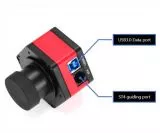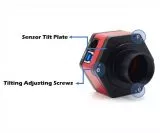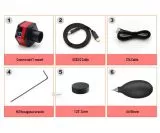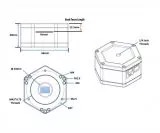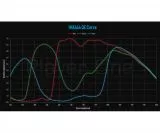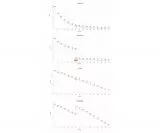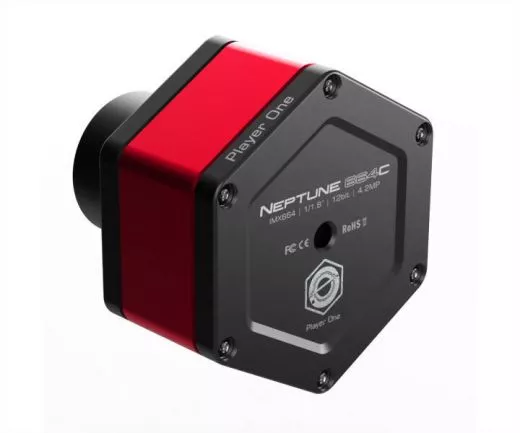TS-Optics Neptune 664C Color Astrokamera, Sony IMX662 Sensor D=9,02 mm
Sensor: 1/1,8" CMOS IMX664 mit 4,15 Megapixeln AuflösungSensorgröße: 7,84 mm x 4,45 mm - Diagonale: 9,02 mmSehr hohe Auflösung: 2,9 µm PixelgrößeSONY STARVIS 2 Technologie - back illuminated Pixel TechnologieMit ca. 91 % QE eine hohe Empfindlichkeit für kurze BelichtungszeitenUSB 3.0 für schnellen Download der BilderSehr geringes AusleserauschenDurch hohe Bildrate sehr gut für EAA geeignet36,5 ke Full Well KapazitätKein Verstärkerglühen (Amp Glow) mehr feststellbarPassive Kühlung mit Wärmeableitung gegen ein Erwärmen des Sensors bei LangzeitbelichtungGute Eignung für Deep Sky AufnahmenAR Schutzfilter eingebaut mit vollem Durchlass auch im InfrarotenInklusive ST4-Level Autoguidingschnittstelle
TS Neptune 664C Farb-Astrokamera, Sony IMX664 Sensor D=9,02 mm
DiePlayer One Neptune 664C ist eine Kamera, die den Sony IMX664-Sensor im 1/1,8"-Format verwendet. Die Pixelgröße von 2,9 µm ermöglicht eine Full-Well-Kapazität von 38,5 ke mit insgesamt 4,2 MP. Die Auflösung beträgt 2704 × 1540 Pixel und die Diagonale 9,02 mm.
Super AR Plus Schutzglas
Die PO664C ist mit einem Super AR Plus beschichteten Schutzglas ausgestattet. Dies garantiert eine sehr hohe Lichtdurchlässigkeit von 310 nm bis 1100 nm und verbessert die Leistung sowohl im Ultraviolett- als auch im N-Bereich.
STARVIS 2 Technologie
Die PO664C basiert auf der Sony STARVIS 2-Technologie mit einem rückseitig beleuchteten CMOS-Bildsensor.
Non-Amp-Glow
Mit Non-Amp-Glow erhält man einen sehr sauberen Hintergrund, so dass es viel einfacher ist, qualitativ hochwertige Bilder zu erstellen.
Sensor-Neigeplatte
Die eingebaute Dichtung verhindert Lichtlecks. Beim Fotografieren der Sonne sind die Newton-Ringe störend. Die Neigeplatte hilft, dieses Phänomen zu vermeiden.
256M DDR3 Cache
Der DDR3-Cache stabilisiert die Datenübertragung, vermeidet effektiv Frame-Dropping und reduziert dasAusleserauschen erheblich.
Mit dem DDR3-Cache hat die Kamera keine hohen Anforderungen mehr an die Rechenleistung, sie hat auch dann noch eine hervorragende Leistung, wenn sie an einen USB 2.0-Port angeschlossen ist.
DPS-Technologie
Die Planetenkameras von Player One Astronomy sind mit der DPS-Technologie (Dead Pixel Suppression) ausgestattet. Die DPS analysiert dunkle Bilder, um tote Pixel zu finden, und zeichnet die Lage im Kameraspeicher auf. Während der Aufnahme wird jedes Bild gefiltert, um tote Pixel zu entfernen.
Überspannungs- und Überstromschutzmechanismus
Die Sicherheit Ihrer Kamera und anderer Geräte wird durch Überspannungs- und Überstromschutzmechanismen gewährleistet.
Datenanschluss
Wenn die Kamera an die USB 3.0-Schnittstelle angeschlossen ist und die Vorschau in voller Auflösung verwendet wird, kann sie 107 FPS im RAW8-Modus (10bit ADC) erreichen. Bei der Aufnahme von Bildern wird die tatsächliche Schreibgeschwindigkeit von der Schreibgeschwindigkeit der Festplatte selbst beeinflusst, so dass bei einer langsamen Schreibgeschwindigkeit der Festplatte die theoretische Geschwindigkeit möglicherweise nicht erreicht wird. Es wird empfohlen, ein hochwertiges Solid-State-Laufwerk für die Datenaufzeichnung zu verwenden, um die Leistung der Kamera voll auszunutzen.
Verwenden Sie das ST4-Kabel, um die Kamera mit dem entsprechenden Anschluss Ihrer Montierung zu verbinden.
Ausleserauschen
Die Werte für das Ausleserauschen wurden bei aktuellen Tests ermittelt, die Sie mit Sharpcap 4 durchführen können. SC4 verfügt über eine Funktion namens Sensor Analysis, mit der sich das Ausleserauschen sehr einfach testen lässt.| Sensor: | SONY IMX664 1/1,8" CMOS (Farbe) |
| Diagonale: | 9 mm |
| Gesamt-Pixel: | 4,2 Megapixel |
| Maximale Auflösung: | 2704 × 1540 |
| Pixelgröße: | 2,9 µm |
| Chip-Größe: | 7,8 mm × 4,5 mm |
| Bildrate: | 136 FPS (10 bit) |
| Bayer-Matrix: | RGGB |
| Verschluß: | Rolling Shutter |
| Belichtungszeiten: | 32 µs - 2000 s |
| Ausleserauschen: | 6,1 - 0,67 e |
| QE-Spitzenwert: | 91 %. |
| Fulkl-Well-Kapazität: | 38,5 ke |
| ADC: | 12 Bit |
| Datenanschluss: | USB 3.0 / USB 2.0 |
| Adapter: | 1,25" / M42 X 0,75 |
| Auflagemaß: | 12,5 mm |
| Schützendes Fenster: | Hochwertige Anti-Reflexions-Mehrschicht- Vergütung |
| Durchmesser: | 66 mm |
| Gewicht: | 180 g |
| Auflösung (USB3.0-Modus) 12 Bit: | 2704×1540 46,5 FPS / 2560×1440 52,5 FPS / 1920×1080 93 FPS / 1280×720 203 FPS / 800×600 240 FPS / 640×480 294 FPS |
| Auflösung (USB3.0-Modus) 10 Bit ADC: | 2704×1540 93 / 2560×1440 105 FPS / 1920×1080 187 FPS / 1280×720 275 FPS / 800×600 325 FPS / 640×480 398 FPS; Weitere Auflösungen können in der Aufnahmesoftware eingestellt werden. |
Kamera
1,25"-Adapter und Abdeckung
Blasebalg
USB 3 Kabel
ST4 Kabel
2-mm-Sechskantschlüssel
DE- Sicherheitshinweise
Nicht geeignet für Kinder unter 3 Jahren.
Verpackung nicht zum Verzehr geeignet.
Verpackung für Kinder unzugänglich aufbewahren. Erstickungsgefahr !
Schauen Sie nie mit einem Teleskop oder Fernglas in die Sonne. Erblindungsgefahr !
Kinder sollten Teleskope und Ferngläser nur in Anwesenheit eines Erwachsenen benutzen.
EN- Safety instructions
Not suitable for children under 3 years of age.
Packaging not suitable for consumption.
Keep packaging out of reach of children. Risk of suffocation!
Never look at the sun with a telescope or binoculars. Risk of blindness!
Children should only use telescopes and binoculars in the presence of an adult.

